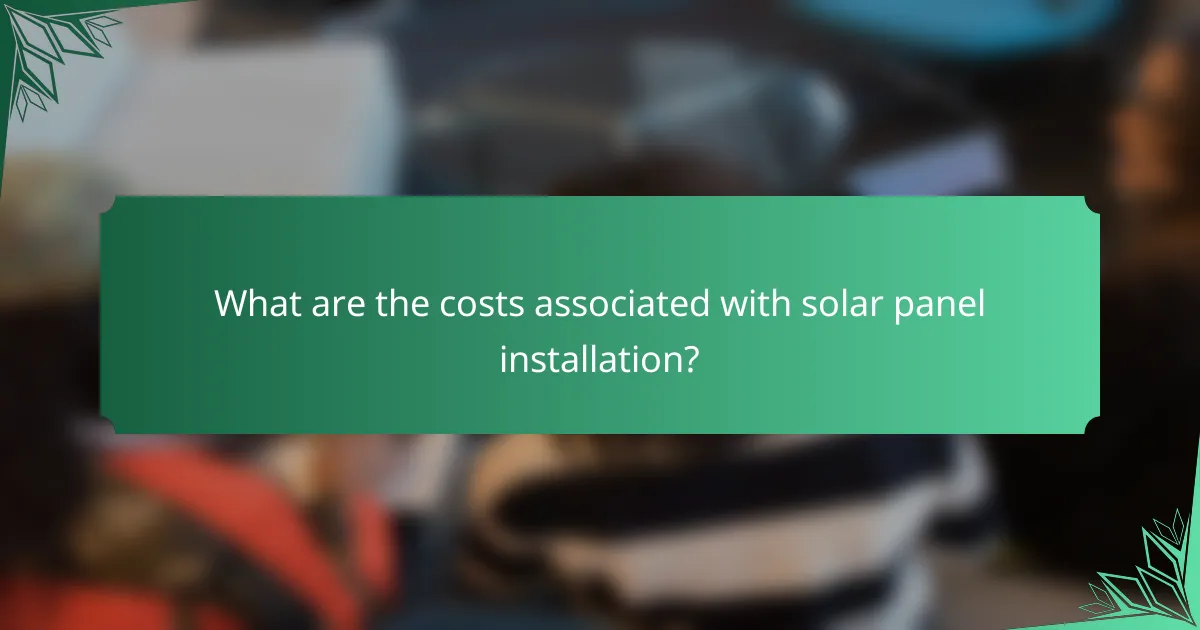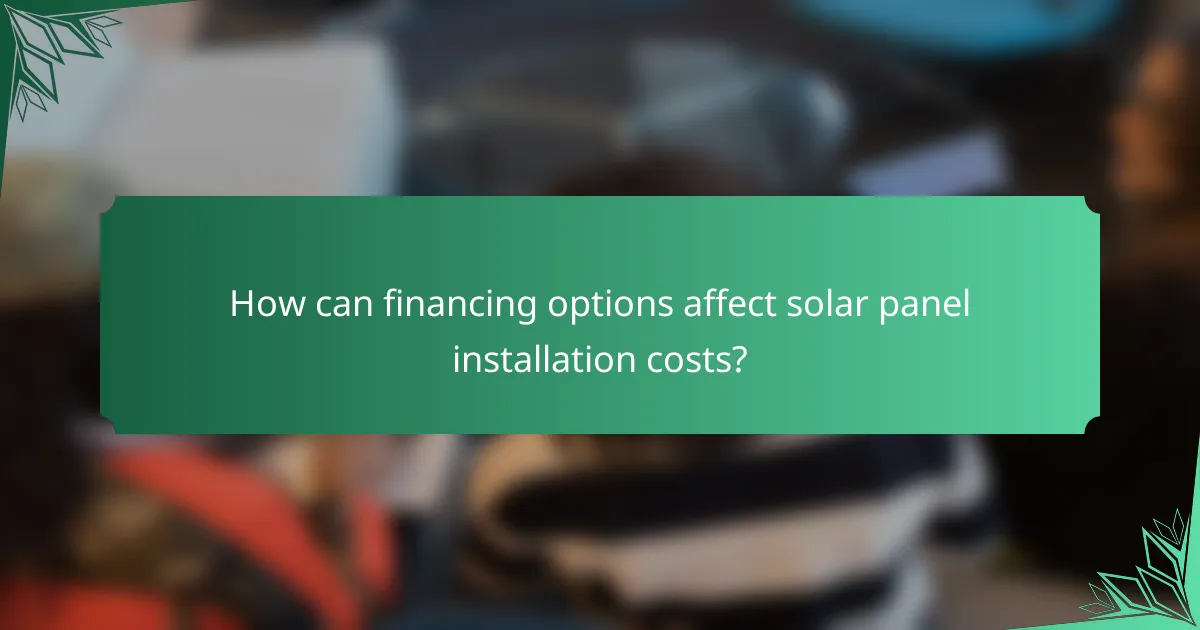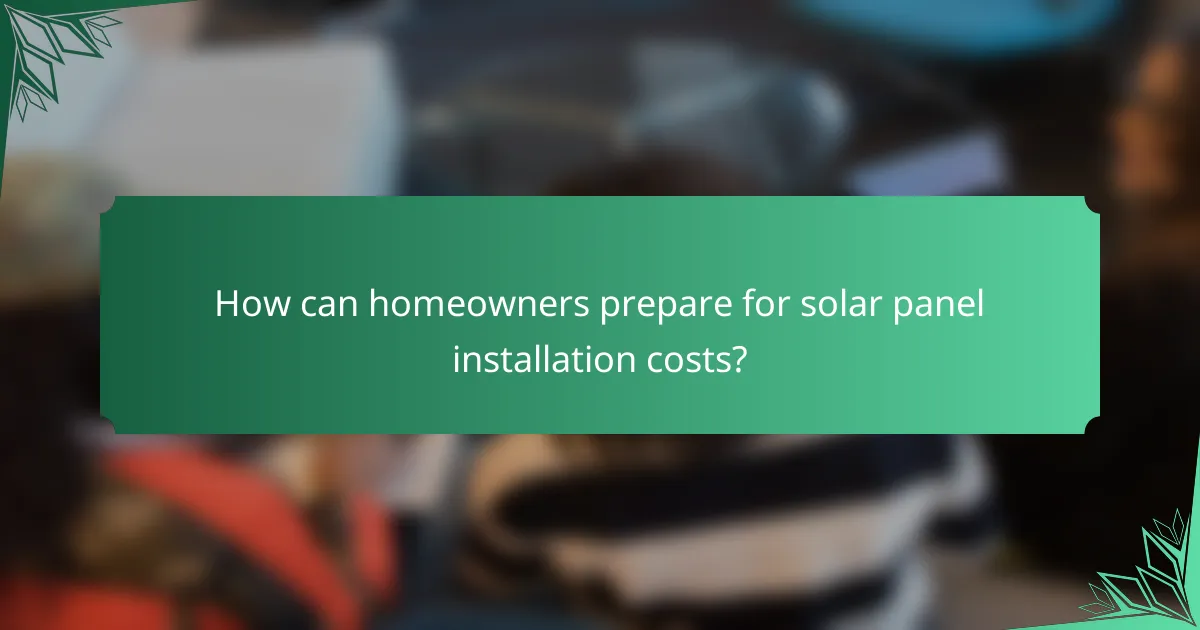
What are the costs associated with solar panel installation?
The costs associated with solar panel installation typically range from $15,000 to $25,000 for an average residential system. This price includes equipment, labor, and permits. The cost per watt averages between $2.50 and $3.50. Factors such as system size, panel type, and installation complexity influence pricing. Additional costs may include maintenance and potential upgrades. Federal tax credits can offset installation costs by up to 26%. Local incentives may further reduce expenses. Overall, the investment can lead to significant long-term savings on energy bills.
How do installation costs vary by region?
Installation costs for solar panels vary significantly by region. For instance, states with high solar incentives, like California, often see lower installation costs due to competition among installers. In contrast, regions with fewer incentives, such as some areas in the Midwest, may have higher costs. Labor rates also differ; urban areas typically have higher labor costs compared to rural regions. According to the Solar Energy Industries Association, the national average for solar installation costs was about $2.77 per watt in 2020, but this can range from $2.50 to $3.50 depending on the region. Additionally, local regulations and permitting fees can influence overall costs, making some regions more expensive than others.
What are the average installation costs in urban vs. rural areas?
Average installation costs for solar panels are typically higher in urban areas compared to rural areas. Urban installation costs average around $3.50 to $4.50 per watt. In contrast, rural areas average between $2.50 to $3.50 per watt. Factors contributing to this difference include labor costs, permitting fees, and material availability. Urban areas often have higher labor rates due to demand. Rural areas may benefit from lower overhead costs. Additionally, urban installations may face more regulatory hurdles, increasing overall expenses.
How do local incentives impact installation costs?
Local incentives significantly reduce installation costs for solar panel systems. These incentives can take the form of tax credits, rebates, or grants provided by local governments. For example, the Federal Investment Tax Credit allows homeowners to deduct a percentage of installation costs from their federal taxes. Additionally, some states offer rebates that can cover a portion of the upfront costs. According to the Solar Energy Industries Association, these incentives can lower costs by 30% or more. Local incentives also encourage more homeowners to adopt solar energy, increasing demand and potentially lowering prices further through economies of scale.
What factors influence solar panel installation prices?
Solar panel installation prices are influenced by several key factors. The cost of solar panels themselves is a primary factor. Prices can vary based on the type and brand of panels chosen. Labor costs for installation also significantly impact overall pricing. These costs can differ based on the region and the complexity of the installation. Additionally, the size of the solar system plays a crucial role. Larger systems generally cost more due to increased materials and labor. Government incentives and rebates can reduce installation costs. Local regulations and permitting requirements can also affect pricing. Lastly, the installation company’s reputation and experience may influence costs, as established companies may charge more for their expertise.
How does the type of solar panel affect installation costs?
The type of solar panel significantly affects installation costs. Different solar panels have varying efficiencies, materials, and installation requirements. For instance, monocrystalline panels are generally more efficient but also more expensive. Their higher efficiency leads to lower overall installation costs for the same energy output. Conversely, polycrystalline panels are less expensive but may require more space and additional installation costs due to lower efficiency. Thin-film solar panels are often cheaper but may have shorter lifespans and lower efficiency, impacting long-term costs. According to the National Renewable Energy Laboratory, installation costs can vary by up to 20% based on panel type. This variation reflects differences in labor, equipment, and system design associated with each panel type.
What role does the size of the solar system play in pricing?
The size of the solar system significantly impacts pricing. Larger systems typically have higher upfront costs due to more solar panels and additional equipment. However, they often benefit from economies of scale, reducing the cost per watt. For instance, a 10 kW system may cost less per watt than a 5 kW system. This price reduction occurs because fixed costs, such as installation labor, are spread over a larger energy output. Additionally, larger systems can generate more energy, leading to greater savings on electricity bills. This increased efficiency can make larger installations more financially attractive in the long run.
How do labor costs vary in different locations?
Labor costs for solar panel installation vary significantly by location. Urban areas typically have higher labor costs due to increased demand and cost of living. In contrast, rural areas often experience lower labor costs owing to reduced demand and lower living expenses. For instance, labor costs can range from $50 to $150 per hour in different regions. According to the Solar Energy Industries Association (SEIA), labor costs account for approximately 10-20% of total installation costs. Additionally, states with strong solar incentives may see increased labor costs due to higher installation volumes. Conversely, areas with fewer solar policies may have stagnant labor rates. Overall, geographical factors, local market conditions, and state regulations play crucial roles in determining labor costs for solar panel installations.
What additional costs should be considered in solar panel installation?
Additional costs in solar panel installation include permits, inspection fees, and potential structural upgrades. Permitting costs vary by location and can range from $100 to $2,000. Inspection fees may also be required, typically costing between $50 and $300. Homeowners might need to invest in structural upgrades if their roofs are not suitable for solar panels. These upgrades can add anywhere from $1,000 to $5,000 to the total cost. Additionally, there may be costs for wiring and electrical work, which can range from $500 to $2,000. Maintenance and insurance costs should also be factored in, averaging around $300 annually.
Are there permits and inspection fees involved?
Yes, there are permits and inspection fees involved in solar panel installation. These fees vary by location and local regulations. Typically, homeowners must obtain building permits before installation. Inspection fees may also apply to ensure compliance with safety standards. For example, some jurisdictions charge between $100 to $500 for permits. Inspection fees can range from $50 to $300. These costs are essential for legal compliance and ensuring system safety and performance.
What are the costs of maintenance and repairs over time?
The costs of maintenance and repairs for solar panels over time typically range from $150 to $300 annually. Regular maintenance ensures optimal performance and longevity. Common maintenance tasks include cleaning panels and inspecting for damage. Repairs can vary significantly based on the extent of damage. Minor repairs may cost around $200, while major issues can exceed $1,000. According to the National Renewable Energy Laboratory, solar panels have a lifespan of 25 years, necessitating periodic maintenance and potential repairs throughout their life. Overall, budgeting for these costs is essential for solar panel owners to maintain efficiency and functionality.

How can financing options affect solar panel installation costs?
Financing options can significantly influence solar panel installation costs. Different financing methods, such as cash purchases, loans, leases, or power purchase agreements (PPAs), alter the upfront costs and long-term financial commitments. Cash purchases require full payment upfront, leading to immediate savings on interest. Loans spread the cost over time but add interest, increasing total expenses. Leases usually have lower initial payments but can result in higher overall costs due to monthly fees. PPAs allow users to pay for electricity generated, often at a lower rate than utility prices, impacting long-term savings. According to the Solar Energy Industries Association, the choice of financing can affect the total cost by thousands of dollars over the system’s lifespan.
What are the common financing options available for solar panel installation?
Common financing options for solar panel installation include cash purchases, solar loans, leases, and power purchase agreements (PPAs). Cash purchases provide full ownership and immediate savings. Solar loans allow homeowners to pay over time while retaining ownership. Leases involve paying a fixed monthly rate to use the system without ownership. PPAs require payment based on the energy produced, often with little to no upfront cost. Each option varies in terms of ownership, monthly payments, and long-term savings potential.
How do solar loans work?
Solar loans allow homeowners to finance the purchase of solar energy systems. These loans typically cover the cost of solar panels, installation, and related equipment. Borrowers make monthly payments over a specified term, usually ranging from five to twenty years. Interest rates on solar loans can vary based on creditworthiness and lender terms. Many solar loans are unsecured, meaning no collateral is required. Some loans offer fixed interest rates, providing predictable monthly payments. Others may have variable rates, which can change over time. Federal programs and incentives may further reduce overall costs, making solar loans more affordable. According to the Solar Energy Industries Association, solar financing options have increased access to renewable energy for many homeowners.
What is the role of leasing in solar installations?
Leasing plays a significant role in solar installations by providing a financing option that allows consumers to access solar energy without the upfront costs. Through leasing, customers can install solar panels on their property while paying a monthly fee to the leasing company. This arrangement often requires little to no down payment, making solar energy more accessible to a broader audience.
Additionally, leasing agreements typically include maintenance and monitoring services, relieving homeowners of the responsibilities associated with system upkeep. This can lead to immediate energy savings, as customers start benefiting from lower electricity bills right away. According to the Solar Energy Industries Association, leasing has contributed to the growth of residential solar markets, expanding access to renewable energy.
What are the benefits of financing solar panel installations?
Financing solar panel installations offers several benefits. It allows homeowners to spread the cost over time. This makes solar energy more accessible to those who cannot afford the upfront payment. Financing options often include low-interest rates, making monthly payments manageable.
Additionally, financing can lead to immediate energy savings. Homeowners start saving on utility bills while paying off the system. Many financing plans also include incentives such as tax credits. These can further reduce the overall cost of the installation.
According to the Solar Energy Industries Association, 70% of solar installations in the U.S. are financed. This statistic highlights the popularity and practicality of financing options in making solar energy more attainable.
How can financing options make solar energy more accessible?
Financing options make solar energy more accessible by reducing upfront costs for consumers. Many homeowners cannot afford the full price of solar panel systems upfront. Financing options such as loans, leases, and power purchase agreements (PPAs) allow consumers to pay over time. This spreads the cost into manageable monthly payments. For example, solar loans can cover the entire system cost, enabling immediate installation. Additionally, leases and PPAs often require little to no upfront payment. According to the Solar Energy Industries Association, these financing methods have contributed to a 167% increase in residential solar installations from 2015 to 2020. Thus, financing options significantly lower financial barriers, making solar energy attainable for more households.
What impact does financing have on overall cost savings?
Financing significantly impacts overall cost savings in solar panel installation. It allows homeowners to spread the upfront costs over time. This makes solar energy more accessible. Lower monthly payments can lead to immediate cash flow benefits. Additionally, financing options like solar loans often come with lower interest rates. These lower rates reduce the total amount paid over the loan’s lifespan. According to the Solar Energy Industries Association, financing can lead to savings of 20% or more over time. This is especially true when considering potential tax credits and incentives.

How can homeowners prepare for solar panel installation costs?
Homeowners can prepare for solar panel installation costs by conducting thorough research and budgeting effectively. First, they should obtain multiple quotes from different solar installation companies. This helps in understanding the market rate and ensures competitive pricing. Next, homeowners should assess their current energy usage to determine the appropriate system size. The average cost of solar panels ranges from $15,000 to $25,000 before incentives, depending on the system size and location.
Homeowners can also explore available tax credits and rebates, which can significantly reduce out-of-pocket expenses. For example, the federal solar tax credit allows homeowners to deduct 26% of the installation cost from their federal taxes. Additionally, financing options such as solar loans or leases can spread the cost over time. Understanding these factors enables homeowners to make informed decisions about their solar investments and prepare for associated costs effectively.
What steps can be taken to reduce installation costs?
To reduce installation costs for solar panels, consider the following steps. First, obtain multiple quotes from different installers. This allows for comparison and negotiation. Second, choose a standard installation package that minimizes customization. Customized installations often lead to higher costs. Third, take advantage of local, state, or federal incentives. These financial incentives can significantly lower upfront expenses. Fourth, consider purchasing equipment outright instead of financing. This can avoid interest charges. Fifth, install during off-peak seasons. Prices may be lower when demand is reduced. Lastly, engage in community solar programs. These programs can lower individual costs through shared resources. Implementing these strategies can lead to noticeable savings on installation costs.
How can homeowners evaluate different contractors for better pricing?
Homeowners can evaluate different contractors for better pricing by obtaining multiple quotes. They should compare the scope of work included in each quote. Homeowners must also check the contractors’ credentials and references. Evaluating customer reviews can provide insights into quality and service. Additionally, understanding the materials used can impact pricing. Homeowners should inquire about warranties and post-installation support. Researching local market rates helps in identifying fair pricing. Finally, considering financing options can affect overall costs.
What factors should be considered when choosing solar panel brands?
When choosing solar panel brands, consider efficiency, warranty, and cost. Efficiency indicates how much sunlight the panels convert into usable energy. Higher efficiency panels generate more power in less space. Warranty reflects the brand’s confidence in their product. A longer warranty often indicates better durability and reliability. Cost should align with your budget while factoring in long-term savings. Research shows that brands with higher initial costs often provide better returns over time through energy savings. Customer reviews and certifications can also provide insights into brand reliability and performance.
What tips can help maximize the value of solar panel investments?
To maximize the value of solar panel investments, homeowners should consider several strategies. First, select high-efficiency solar panels. Higher efficiency panels convert more sunlight into electricity, providing greater energy savings. Second, install the system in a location with optimal sun exposure. This increases energy production and reduces payback time. Third, take advantage of available tax credits and incentives. For example, the federal solar tax credit allows homeowners to deduct 26% of the cost of their solar system from their federal taxes. Fourth, perform regular maintenance on the solar system. This ensures it operates at peak efficiency and prolongs its lifespan. Fifth, consider battery storage options to store excess energy. This allows homeowners to use solar energy even when the sun isn’t shining. Lastly, monitor energy usage and adjust consumption patterns. Reducing usage during peak hours can further enhance savings. These tips can significantly increase the financial returns on solar investments.
How can homeowners take advantage of local incentives and rebates?
Homeowners can take advantage of local incentives and rebates by researching available programs in their area. Many local governments and utility companies offer financial incentives for solar panel installation. These incentives can significantly reduce the overall cost of installation. Homeowners should check their local energy office or utility website for specific programs. Additionally, they can consult with solar installation companies that often have information on available rebates. Many incentives are time-sensitive, so acting quickly is beneficial. According to the Database of State Incentives for Renewables & Efficiency (DSIRE), numerous states provide various financial incentives for solar energy.
What are the best practices for maintaining solar panels to reduce long-term costs?
Regular cleaning of solar panels enhances efficiency and longevity. Dust, dirt, and debris can obstruct sunlight absorption. Cleaning should occur at least twice a year, or more frequently in dusty areas. Use soft brushes or squeegees with water to avoid scratches.
Inspecting for damage is crucial. Check for cracks, loose connections, or corrosion. Early detection prevents costly repairs.
Monitoring system performance helps identify issues. Use monitoring software to track energy output. A significant drop in output may indicate a problem.
Trimming surrounding vegetation prevents shading. Overhanging branches can block sunlight and reduce efficiency.
Professional maintenance is beneficial. Consider hiring experts for annual inspections. They can ensure optimal performance and address any issues.
These practices can significantly reduce long-term maintenance costs by enhancing efficiency and preventing major repairs.
Solar panel installation costs for residential systems typically range from $15,000 to $25,000, influenced by factors such as system size, panel type, and regional pricing variations. This article explores the key elements affecting installation prices, including labor costs, local incentives, and additional expenses like permits and maintenance. Furthermore, it examines various financing options available to homeowners, such as loans, leases, and power purchase agreements, which can significantly impact overall costs and accessibility to solar energy. By understanding these factors, homeowners can make informed decisions about their solar investments and maximize savings.